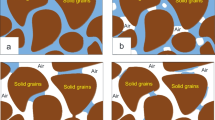Abstract
This paper presents a 3D moisture-stress numerical analysis for timber structures under variable humidity and load conditions. An orthotropic viscoelastic-mechanosorptive material model is specialized on the basis of previous models. Both the constitutive model and the equations needed to describe the moisture flow across the structure are implemented into user subroutines of the Abaqus finite element code and a coupled moisture-stress analysis is performed for several types of mechanical loads and moisture changes. The presented computational approach is validated by analyzing some wood tests described in the literature and comparing the computational results with the reported experimental data.
Similar content being viewed by others
References
Abaqus: Abaqus/Standard, Theory Manual. Version 6.5. Hibbitt, Karlsson and Sorensen, Inc., Pawtucket (2004a)
Abaqus: Abaqus/Standard, User’s Manual. Version 6.5. Hibbitt, Karlsson and Sorensen, Inc., Pawtucket (2004b)
Aicher, S., Dill-Langer, G.: Effect of lamination anysotropy and lay-up in glued-laminated timbers. J. Struct. Eng. 131(7), 1095–1103 (2005)
André, J.: Strengthening of timber structures with flax fibres. Technical Report 61, Licentiate Thesis, Department of Civil, Mining and Environmental Engineering, Luleå University of Technology (2007)
Avramidis, S.: Evaluation of the “three-variable” models for the prediction of equilibrium moisture content in wood. Wood Sci. Technol. 23, 251–258 (1989)
Avramidis, S., Siau, J.: An investigation of the external and internal resistance to moisture diffusion in wood. Wood Sci. Technol. 21, 249–256 (1987)
Chassagne, P., Bou-Saïd, E., Jullien, J., Galimard, P.: Three dimensional creep model for wood under variable humidity—numerical analyses at different material scales. Mech. Time-Depend. Mater. 9, 203–223 (2006)
de Moura, M., Silva, M., de Morais, A., Morais, J.: Equivalent crack based mode ii fracture characterization of wood. Eng. Fract. Mech. 73, 978–993 (2006)
Dubois, F., Petit, C.: Modelling of the crack growth initiation in viscoelastic media by the Gθ v -integral. Eng. Fract. Mech. 72, 2821–2836 (2005)
Frandsen, H.: Selected constitutive models for simulating the hygromechanical response of wood. Technical Report no 10, Dissertation, Department of Civil Engineering, Aalborg University (2007)
Hanhijärvi, A.: Modelling of creep deformation mechanisms in wood. Technical Report no 231, Dissertation, VTT Technical Research Centre of Finland (1995)
Hanhijärvi, A., Mackenzie-Helnwein, P.: Computational analysis of quality reduction during drying of lumber due to irrecoverable deformation. i: Orthotropic viscoelastic-mechanosorptive-plastic material model for the tranverse plane of wood. J. Eng. Mech. 129(9), 996–1005 (2003)
Helnwein, P.: Some remarks on the compressed matrix representation of symmetric second-order and fourth ordes tensors. Comput. Methods Appl. Mech. Eng. 190(22–23), 2753–2770 (2001)
Jönsson, J.: Moisture induced stresses in timber structures. Technical Report TVBK-1031, Dissertation, Division of Structural Engineering, Lund University of Technology (2005)
Leivo, M.: On the stiffness changes in nail plate trusses. Technical Report no 80, Dissertation, VTT Technical Research Centre of Finland (1991)
Liyu, W., Zhenyou, L., Guangjie, Z.: Wood fracture pattern during the water adsorption process. Holzforschung 57(6), 639–643 (2003)
Mackenzie-Helnwein, P., Hanhijärvi, A.: Computational analysis of quality reduction during drying of lumber due to irrecoverable deformation. ii: Algorithmic aspects and practical application. J. Eng. Mech. 129(9), 1006–1016 (2003)
Mackenzie-Helnwein, P., Eberhardsteiner, J., Mang, H.: A multi-surface plasticity model for clear wood and its application to the finite element analysis of structural details. Comput. Mech. 31, 204–218 (2003)
Malvern, L.: Introduction to the Mechanics of a Continuous Medium. Prentice–Hall, Englewood Clifs (1969)
Marsden, J., Hughes, T.: Mathematical Foundation of Elasticity. Dover, New York (1992)
Maugin, G.: The Thermomechanics of Plasticity and Fracture. Cambridge University Press, Cambridge (1992)
Ormarsson, S.: Numerical analysis of moisture-related distorsions in sawn timber. Technical Report Ny serie no 1531, Dissertation, Chalmers University of Technology (1999)
Ranta-Maunus, A.: Effects of climate and climate variations on strength. In: Thelandersson, S., Larsen, H.J. (eds.) Timber Engineering. Wiley, New York (2003)
Rosen, H.: The influence of external resistance on moisture adsorption rates in wood. Wood Fiber 10(3), 228–229 (1978)
Santaoja, K., Leino, T., Ranta-Maunus, A., Hanhijärvi, A.: Mechano–sorptive structural analysis of wood by the Abaqus finite element program. Technical Report 1276, VTT Technical Research Centre of Finland (1991)
Schmidt, J., Kaliske, M.: Models for numerical failure analysis of wooden structures. Eng. Struct. 31, 571–579 (2009)
Sih, G., Michopoulos, J., Chou, S.: Hygrothermoelasticity. Nijhoff, Dordrecht (1986)
Simo, J., Hughes, T.: Computational Inelasticity. Springer, New York (1998)
Sjödin, J.: Steel-to-timber dowel joints—influence of moisture induced stresses. Technical Report no 31, Licentiate Thesis, Växjö University (2004)
Toratti, T.: Creep of timber beams in a variable environment. Technical Report no 31/TRT, Dissertation, Helsinki University of Technology (1992)
Toratti, T., Svensson, S.: Mechano-sorptive experiments perpendicular to grain under tensile and compressive loads. Wood Sci. Technol. 34, 317–326 (2000)
Toratti, T., Svensson, S.: Mechanical response of wood perpendicular to grain when subjected to changes of humidity. Wood Sci. Technol. 36, 145–156 (2002)
Vasic, S., Stanzl-Tschegg, S.: Experimental and numerical investigation of wood fracture mechanisms at different humidity levels. Holzforschung 61, 367–374 (2007)
Vidal-Sallé, E., Chassagne, P.: Constitutive equations for orthotropic nonlinear viscoelastic behaviour using a generalized Maxwell model—application to wood material. Mech. Time-Depend. Mater. 11, 127–142 (2007)
Zuritz, C., Singh, R.P., Moini, S.M., Henderson, S.M.: Desorption isotherms of rough rice from 10°C to 40°C. Trans. ASAE 22, 433–440 (1979)
Author information
Authors and Affiliations
Corresponding author
Rights and permissions
About this article
Cite this article
Fortino, S., Mirianon, F. & Toratti, T. A 3D moisture-stress FEM analysis for time dependent problems in timber structures. Mech Time-Depend Mater 13, 333–356 (2009). https://doi.org/10.1007/s11043-009-9103-z
Received:
Accepted:
Published:
Issue Date:
DOI: https://doi.org/10.1007/s11043-009-9103-z




